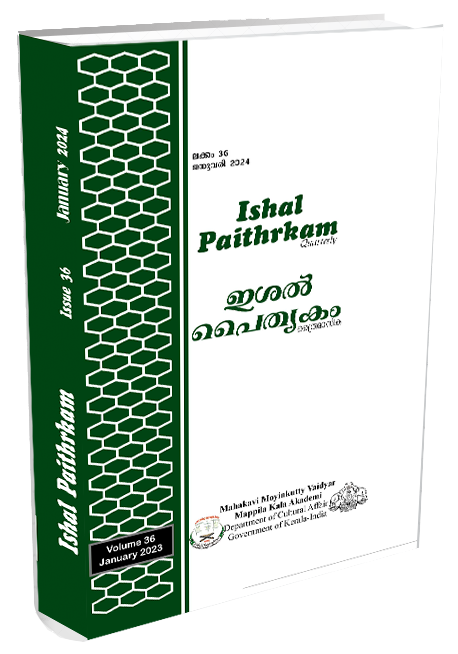Mappila Labourers and the Plantations of Malabar: A Colonial Experience
Abstract
Plantations were a product of colonialism. Commercialization of agriculture gave way for the emergence of plantations all over the world. In the agrarian sector introduction of plantation and commercial agriculture created demand for agricultural labourers who would be relatively free from the feudal obligations of wetland agriculture mediated by the traditional relations of production.1The earliest foreign investment in the region had been in spice plantations begun by Murdoch Brown in Anjarakandy near Tellicherry. After defeating Pazhassi Raja, Wayanad came under the control of British rule. In Wayanad, Coffee plantations were started first then followed by tea plantation. In the late nineteenth century investments were made in the cool, well watered Western Ghats, which had easy access to ocean transport. This region was highly suitable for tea and rubber plantations. Permanent supply of labour was an integral part of plantation industry. Mappila labourers were an integral part of plantations of Malabar. This paper tries to locate the mappilas as labourers and also as rebels in the plantations of Malabar during the colonial period. Mappila Muslims of Malabar was a community that arose as a result of the interactions and engagements between the Islamic Arab traders and coastal communities of western coast of India.2 Before the arrival of European trade on the western coast of India in 1490 muslim merchants had stimulated a brisk trade with the local princes in the Malabar coast and also with a network of traders from the Middle East and the eastern coast of Africa.3 The fragmented character of a Malabar polity with a large number of principalities enabled the Portuguese to establish a control in the coastal regions and impose their system of maritime control. The political and economic interests of the Portuguese on the Malabar Coast brought several concerns to both the ruler Zamorin and Mappila merchants of Calicut. Mappilas considered them as a threat to their political, economic, and commercial interests in the region.4The early decades of the sixteenth century witnessed the conflict between the Portuguese and Muslims, that resulted in the economic marginalization and gradual withdrawal of the latter into the interior of Malabar.5
Downloads
References
Mohan. P, Sanal, Modernity of Slavery: Struggle against caste inequality in colonial Kerala, New Delhi, 2015, p.17.
Roland Miller, Mappila Muslims of Kerala: A Study in Islamic Trends, Hyderabad, 1992, pp. 30-36.
KV. Krishna Ayyar, The Zamorins of Calicut, Calicut, 1938.
Hussain Randathani, Mappila Muslims: A Study on Society and Anti-colonial Struggles, Calicut,2007, pp. 67-68.
Santhosh Abraham, Constructing the “Extraordinary Criminals: Mappila Muslims and Legal Encounters in Early British Colonial Malabar”, Journal of World History , June/September 2014, Vol. 25, No. 2/3 (June/September 2014), pp. 373-395 Stable URL: https://www.jstor.org/stable/43818486
See K. N. Panikkar, Against Lord and State: Religion and Peasant Uprisings in Malabar, 1836-1921, New Delhi, 1989.
K.N. Panikkar, Ed. Peasant Protests and revolts in Malabar, ICHR, New Delhi, 1990, p. viii.
Details look KN. Panikkar,’ Peasant Exploitation in Malabar in the Nineteenth Century’, Journal of Kerala Studies, Vol. IX, Parts 1-4, 1984, pp.155-86.
F.B. Evans and C.A. Innes, Notes on Tenancy Legislation, Madras, 1915, Appendix.
K.N. Panikkar Ed., op.cit., p. xi.
D. R. Banaji, Slavery in British India, Bombay, 1933, p.61. For details look Parlimentary Papers, Judicial, 1828, pp. 565-717.
Madras Mail, ‘ Is Wayanad Healthy ?’ 8 May 1986, p.5.
Cited in Dilip Menon, Caste, Nationalism and Communism in South India, Malabar, 1900-1948, New Delhi, 1994, p.15.
Census of India, 1911, XIII, Madras, part I, Report.27.
Cited in K. Ravi Raman, Global Capital and Peripheral Labour –The History and Political Economy of Plantation Workers in India, London, 2015, p.72.
R. H. Hitchock, Peasant Revolts in Malabar: A History of the Malabar Rebellion 1921, New Delhi, 1983, p. 176.
Dr. P.T.Sebastian, Christian Migration to Malabar 1930-1980, unpublished Ph.D. Thesis, Calicut University, 2002, pp.299-350.
Planting Opinion, 21st Nov., UPASI, 1896, p. 14.
Planting Opinion, 23 Jan. 1897, p.17. Also see Report of the South India Planters’ Enquiry Committee, Madrass, Govt. Press 1986 Appendix IX, p. 94.
Census of India 1921, Madras, Vol. XIII, pt. I, pp.219-21.
R. Bourne, Nilambur Valley Working Plan, Vol. II, 1917-18, Madras, 1921, p.1.
C.H. Jayasree, Slavery and Serfdom in Kerala in the 19th century with special reference to Malabar, unpublished Ph.D. Thesis, Manglore University, 1995, p. 229.
D. V. Rege, Report on an enquiry into conditions of labour in plantations in India, Labour Investigation Committee, Shimla, 1946, p. 127. Here after Rege Committee Report.
Interview with Kadheesumma, 82 years old female, retired plantation worker of Pullenkode Rubber Estate, Malappuram, on 8.8.2010.
Report of the South of India Planters’ Enquiry Committee, Op. cit,. p.89
K. Madhavan Nair, a leader of the freedom struggle in Malabar and eyewitness to the Rebellion of 1921.
K. Madavan Nair, Malabar Rebellion, Kozhikode, 4th edition 2012, p.149.
Public department, G.O. No. 1086, dated 27th December 1922, cited in K.N. Panikkar, Ed., op.cit.,p.385.
Downloads
Published
Issue
Section
License
Copyright (c) 2025 ISHAL PAITHRKAM

This work is licensed under a Creative Commons Attribution-NoDerivatives 4.0 International License.

